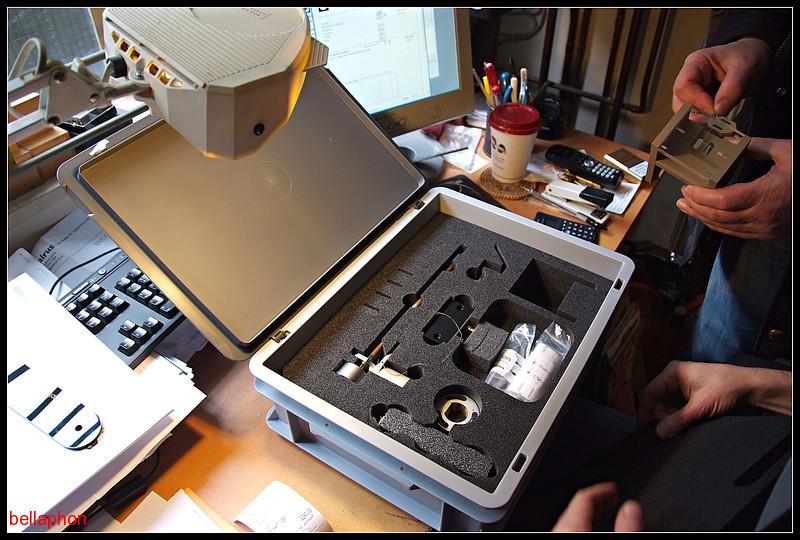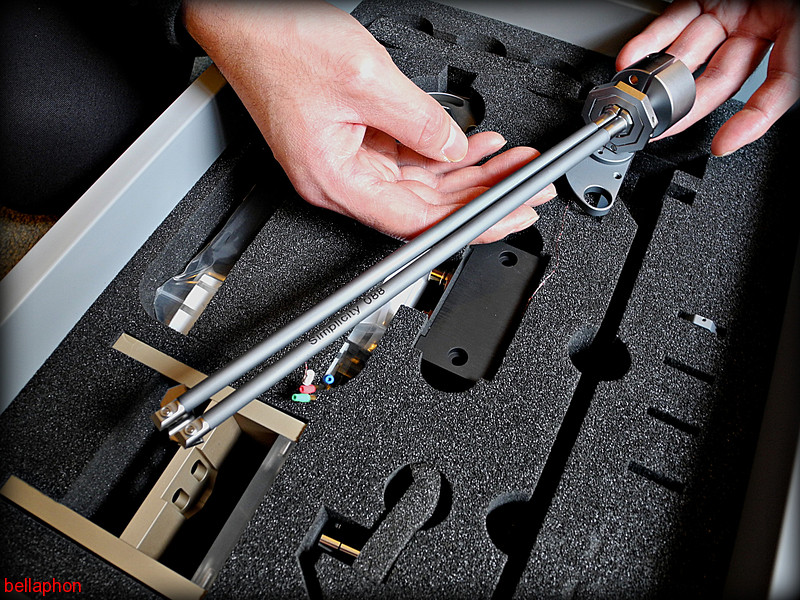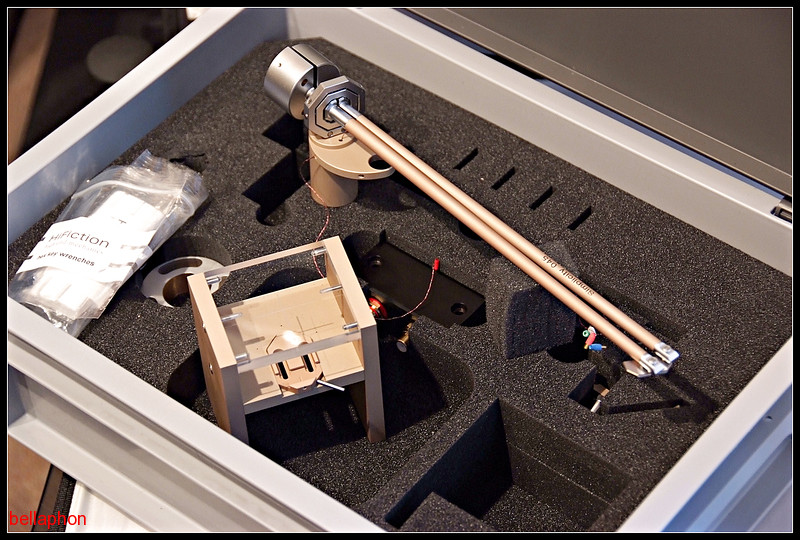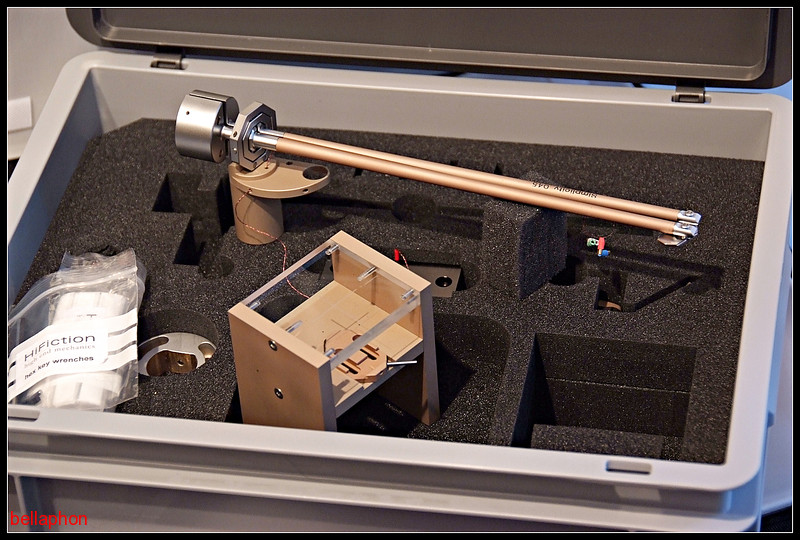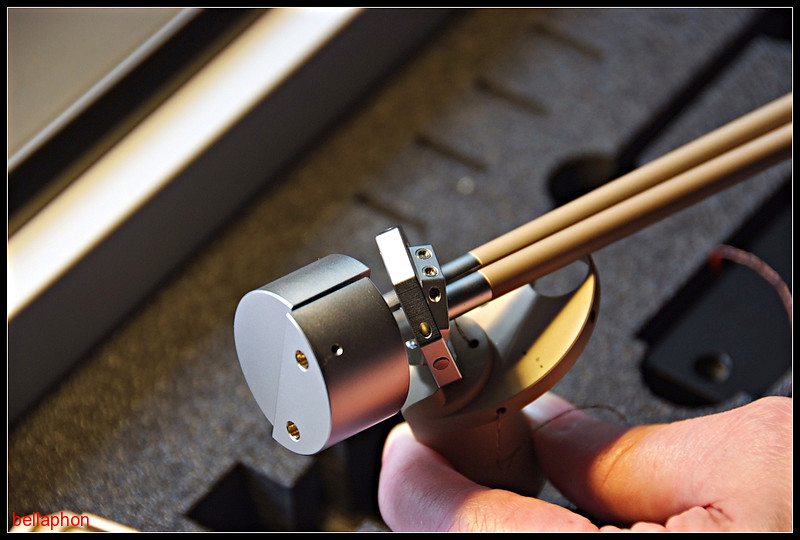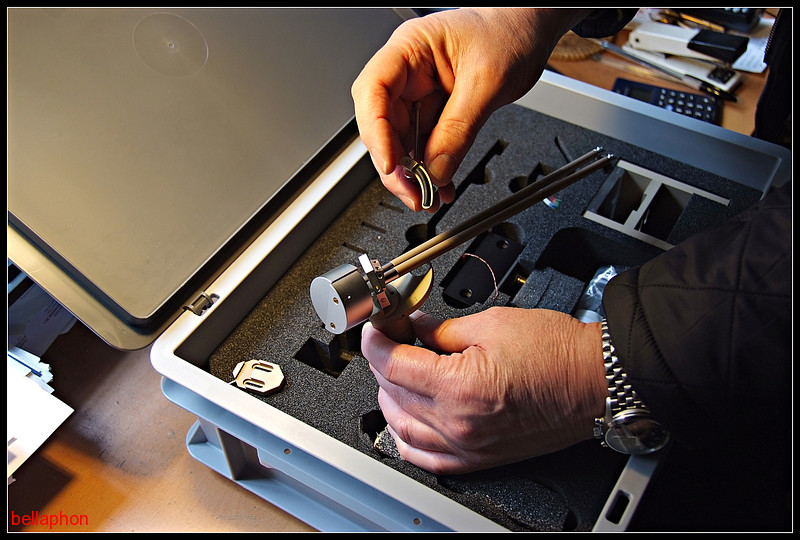You would think for that kind of money, the designer would address the issue of eccentric records and make some kind of mechanism to center the record a la Nakamichi,
or even fettle up a jig to punch a hole in the centre of the record.
Cheers Steve
You would think for that kind of money, the designer would address the issue of eccentric records
As for the Dereneville turntable, it may be a little too chip for some rich Russian audiophiles...
Actually, very impressive indeed.
Taking into attention that usual record eccentricity brings more wow, than most turntable drive systems (and so, should be among sound enemies #1), it is a bit ridiculous, that said Nakamichi Center Search system didn't inspire followers among TT designers. Unfortunately, smartest ideas often aren't most popular.or even fettle up a jig to punch a hole in the centre of the record.
Cheers Steve
As for the Dereneville turntable, it may be a little too chip for some rich Russian audiophiles...
Actually, very impressive indeed.
Last edited:
More weaponry...
The cartridge looks like a Shure V15 Type 3. Well, at least I can afford that! 🙂
An externally hosted image should be here but it was not working when we last tested it.
An externally hosted image should be here but it was not working when we last tested it.
An externally hosted image should be here but it was not working when we last tested it.
An externally hosted image should be here but it was not working when we last tested it.
The cartridge looks like a Shure V15 Type 3. Well, at least I can afford that! 🙂
Last edited:
If you're not easily intimidated that behemoth will make you seriously dissatisfied with the rest of your system. How are you going to feel, playing Jackie Lee's The Duck ? Wagner only, methinks. My old Dad used to say that the Vincent motorcycle was a collection of solutions looking for a problem.
I love that one.My old Dad used to say that the Vincent motorcycle was a collection of solutions looking for a problem.
Double smile, one looking at this, hum, turntable, one reading this comment.
Amazing! I wonder how many needles were broken dialing this rube goldberg device in?
Regards
David
Regards
David
It's almost rude, the way those counterweights sliiide past each other. Oh, here comes the nurse with my meds. Ciao.
Cheers Steve
Cheers Steve
A detail that I hadn't noticed before...
...on the Thales arm is that the pivot for the cartridge mount is forward of the mounting screws. It amazes me that so few tonearms take this into consideration. That way when you make an adjustment to align the cartridge it is much closer to the stylus (vertically above it), and thus align it more precisely. I suspect that because of this, the anti-skating force applied can be greatly reduced. In fact to me this makes the only sense (other than pure tangential arms) regarding arms that have a rotating headshell.
Maybe I'm completely wrong, in which case I'll enjoy any other explanations.
...on the Thales arm is that the pivot for the cartridge mount is forward of the mounting screws. It amazes me that so few tonearms take this into consideration. That way when you make an adjustment to align the cartridge it is much closer to the stylus (vertically above it), and thus align it more precisely. I suspect that because of this, the anti-skating force applied can be greatly reduced. In fact to me this makes the only sense (other than pure tangential arms) regarding arms that have a rotating headshell.
Maybe I'm completely wrong, in which case I'll enjoy any other explanations.
Last edited:
the pivot for the cartridge mount is forward of the mounting screws. It amazes me that so few tonearms take this into consideration. That way when you make an adjustment to align the cartridge it is much closer to the stylus (vertically above it), and thus align it more precisely. I suspect that because of this, the anti-skating force applied can be greatly reduced. In fact to me this makes the only sense (other than pure tangential arms) regarding arms that have a rotating headshell.
Nanook, I guess you don't check this thread much. Yes, the pivot on the headshell is precisely above the stylus tip. Almost all tonearms with rotating headshell mentioned on this thread have that. As I said earlier about the RS Labs tonearm, it uses a rotating headshell NOT for tangential tracking but to reduce anti-skating force, since it does not have a guiding mechanism to simulate a Thales circle (or close to a Thales circle). The Simplicity provides an alignment jig to precisely place the stylus tip vertically below the pivot.
An externally hosted image should be here but it was not working when we last tested it.
An externally hosted image should be here but it was not working when we last tested it.
An externally hosted image should be here but it was not working when we last tested it.
An externally hosted image should be here but it was not working when we last tested it.
The chopsticks looking Simplicity uses the left wand as the main wand and the right wand as the guiding arm. Check some more pictures in this Taiwanese website.
Here are few more close up pictures of the headshell so you get a better idea:
An externally hosted image should be here but it was not working when we last tested it.
An externally hosted image should be here but it was not working when we last tested it.
An externally hosted image should be here but it was not working when we last tested it.
I personally prefer the design of the Simplicity model over the Original model for its, well, simplicity and less linkages. Conceptually, this arm and the new Schroeder LT arm are two of the best designs in this genre of arms. At least they appear to be more user friendly.
.
Similarities between Van Eps Lab & Thales Simplicity tonearms
The Thales Simplicity obviously pays homage to the Garrard Zero 100 and Burn-Jones tonearm. There's a predecessor that's less well known, the Van Eps Laboratory 2A tonearm by Robert Van Eps. Recently there's an owner selling this extremely rare arm on eBay and here's what he has to say:
Here are the pictures posted by the seller:
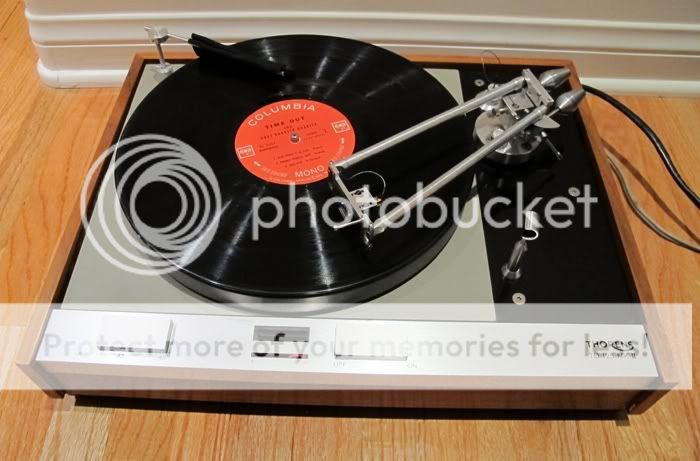
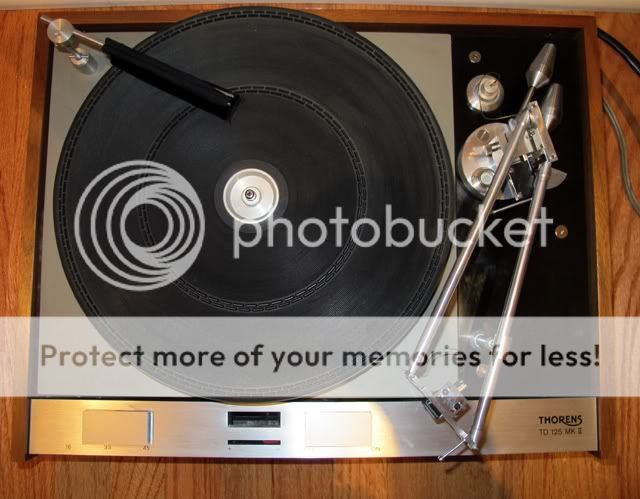

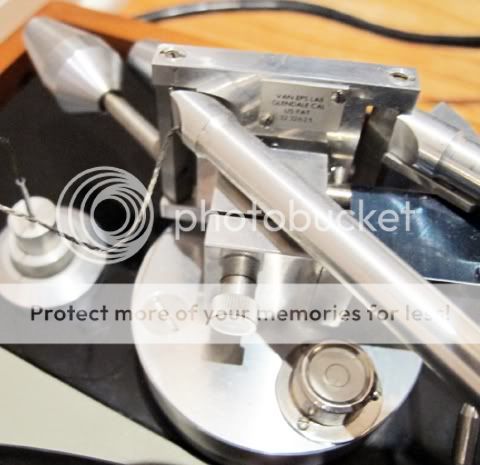


.
The Thales Simplicity obviously pays homage to the Garrard Zero 100 and Burn-Jones tonearm. There's a predecessor that's less well known, the Van Eps Laboratory 2A tonearm by Robert Van Eps. Recently there's an owner selling this extremely rare arm on eBay and here's what he has to say:
This auction is for a mint Van Eps 2A dual-compensating tonearm on the original Thorens TD-125 it was sold with. I am the original owner of this unit. It is in excellent cosmetic condition and in working condition. Complete with original instructions, original dust cover, Van Eps record cleaning brush, and Shure V15 Type IV cartridge. All parts will be packed carefully. These arms were hand built with amazing precision and were sold to many recording studios in the LA area during the 1960s. Thanks for taking a look.
Here are a couple excerpts from the documentation:
"The principal features of the new Dual Arm lie with the complete elimination of tracking error, as well as the complete elimination of torque. Another very important feature is the ballast in the area of the pickup forming the correct amount of mass assets for a given stylus compliance, and this mass asset is directionally poised to counter the vertical and lateral thrusts as set up by the typical stereo groove. Another feature shows in the ability of Dual Arm to carry this mass with perfect tracking performance at only 1/2 gram of tracking pressure under heavy modulation. Last, but by no means least, is the almost complete absence of mass inertia in the lateral compliance, or journeying movement of the arm, itself. This means that, now, for the first time in the history of disc recordings, a record may be played back exactly as it was cut, with a degree of success that leaves the listener with an unforgettable experience. It cannot be described -- it must be heard."
"The VE 2A Dual Compensating Arm is not a parallelogram. Rather, it presents a new geometric curve, whereby non parallel twin arms, linked together at either end, effect just enough continuous compensating adjustment, to allow the stylus to vary it's angle with either arm, but NOT with the passing groove. For the first time in the history of the recording industry, a disc may be played back as it was cut, since the stylus must now remain in one vertical-lateral posture throughout, thereby tracing every cut impartially."
Here are the pictures posted by the seller:






.
another Van Eps 2A tonearm
Here's another one that was sold on eBay:
Here's the auction description:
.
Here's another one that was sold on eBay:
Here's the auction description:
Super rare, extremely well made Van Eps 2A Dual Compensating Playback Arm. The twin arms are arranged geometrically to follow the tangent path of the record groove for zero tracking error. Please read brochure scans at the bottom of the pics below for more information.
As can been seen in the pictures this tonearm is complete and in superb condition. There is no slop in the bearings and the wiring tests perfect. I used this arm sparingly over the years and it is indeed one the best tracking/sounding arm I know of. Recently tested, cleaned and removed from a working turntable.
It comes complete with original plug-in phono cables with ground strap, armrest, Thorens 125 armboard, extra spacer to raise arm, “Van Eps” plaque, accessory record cleaner and a copy of a sales brochure. The phono cartridge pictured is not included, it was mounted just to keep the front of the arm down for picture taking.
Developed in the early 60's and sold over the years in limited numbers due to the time consumption and high cost of making them. They were always expensive, the last list price I could find was $1850 back in 1988. At that time they were sold by Win Labs who bought the remaining parts and rights and sold them under the name, "Pentograph". It is truly one of the best tonearms of all times.
An externally hosted image should be here but it was not working when we last tested it.
An externally hosted image should be here but it was not working when we last tested it.
An externally hosted image should be here but it was not working when we last tested it.
An externally hosted image should be here but it was not working when we last tested it.
An externally hosted image should be here but it was not working when we last tested it.
An externally hosted image should be here but it was not working when we last tested it.
An externally hosted image should be here but it was not working when we last tested it.
An externally hosted image should be here but it was not working when we last tested it.
An externally hosted image should be here but it was not working when we last tested it.
An externally hosted image should be here but it was not working when we last tested it.
An externally hosted image should be here but it was not working when we last tested it.
An externally hosted image should be here but it was not working when we last tested it.
An externally hosted image should be here but it was not working when we last tested it.
An externally hosted image should be here but it was not working when we last tested it.
An externally hosted image should be here but it was not working when we last tested it.
An externally hosted image should be here but it was not working when we last tested it.
An externally hosted image should be here but it was not working when we last tested it.
An externally hosted image should be here but it was not working when we last tested it.
An externally hosted image should be here but it was not working when we last tested it.
An externally hosted image should be here but it was not working when we last tested it.
An externally hosted image should be here but it was not working when we last tested it.
An externally hosted image should be here but it was not working when we last tested it.
.
"I did not realize it had two counterweights."
Yes, it has two counterweights, each one to balance out the armwand. On the main armwand, there's an extra weight at the back to set tracking force.
Here's the instruction I found online about setting the tracking force.
An externally hosted image should be here but it was not working when we last tested it.
You see the relationship between the Van Eps arm and the mysterious stringed arm?
Which one do you prefer?
Which one do you prefer?
An externally hosted image should be here but it was not working when we last tested it.
DD, thanks (as usual) for the information...
I have a Garrard SB-Zero100 and always thought the arm does have some issues, but apparently has good tracking capabilities. Wish the bearings for the "drag arm" had a better finish.
Looking at the Van Eps, it does inspire some hope for the Garrard. Make a new headshell, and extend the drag link, so that it is similar to the Van Eps. I also have a Yamaha PF1000 with a "twin tube" tonearm, but does not pivot at the headshell. With some work it may be able to be modified.
I have a Garrard SB-Zero100 and always thought the arm does have some issues, but apparently has good tracking capabilities. Wish the bearings for the "drag arm" had a better finish.
Looking at the Van Eps, it does inspire some hope for the Garrard. Make a new headshell, and extend the drag link, so that it is similar to the Van Eps. I also have a Yamaha PF1000 with a "twin tube" tonearm, but does not pivot at the headshell. With some work it may be able to be modified.
I have a Garrard SB-Zero100 and always thought the arm does have some issues, but apparently has good tracking capabilities. Wish the bearings for the "drag arm" had a better finish.
High quality Japanese ball bearings are easy available. I mean, there is some sense in replacing originals on ZERO-100 with the modern ones , they are dust protected and oil-free. Also inexpensive at all.
extend drag length
Don't just extend without doing a careful layout. The non-parallel configuration behaves differently than the parallel Garrard, with different lengths a la the Thales and Van Eps. Fascinating.
Don't just extend without doing a careful layout. The non-parallel configuration behaves differently than the parallel Garrard, with different lengths a la the Thales and Van Eps. Fascinating.
guys, relax...
Firstly I know better bearings are available. But the "drag arm" essentially has one end sit into a cup, and the other a small cartridge type bearing.
Regarding "just extending the drag arm", Obviously I would make a new headshell that could accommodate the extended drag arm and do the geometry before actually starting.
Firstly I know better bearings are available. But the "drag arm" essentially has one end sit into a cup, and the other a small cartridge type bearing.
Regarding "just extending the drag arm", Obviously I would make a new headshell that could accommodate the extended drag arm and do the geometry before actually starting.
- Home
- Source & Line
- Analogue Source
- Angling for 90° - tangential pivot tonearms
